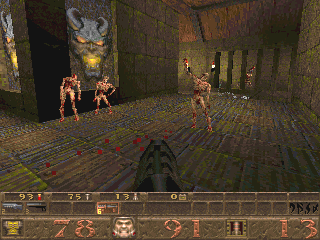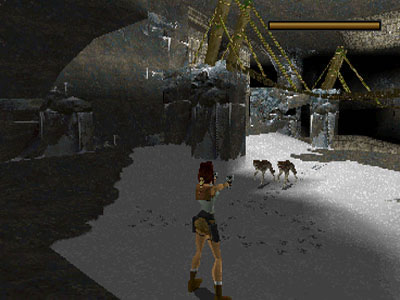History of Computer game, 2000s to today.
Of the sixth generation consoles, the PS2 was the most successful. It was released March 4th 2000 in Japan and October 26th in other countries. Over 150 million were sold, and that’s still increasing. I still see PS2s being sold in game shops. It also had the widest selection of games. Hit titles seen on the Playstation 1 had their series continued on for the PS2. Game companies took full advantage of what the PS2 was capable of. For example, the Tomb Raider series and the Resident Evil series had a range of games developed for it. Towards the end of the 6th generation, some amazing games had been created, pushing the boundaries of the PS2 software, examples like God of War 2 and Shadow of the Colossus.
The other consoles that were part of this generation were the Microsoft Xbox, Nintendo GameCube and Sega Dreamcast. The Xbox was released 15th November 2001. This console, however, was far behind the success of the PS2 for numerous reasons. It did not sell very well in Japan since they did not take well to non-Japanese controllers. The Xbox controllers were bulky and heavy. So Microsoft was forced to come up with a slimmer version that comes with the Japanese console, and as an add-on purchase for the US and European markets. This was down to poor research, as they did not check for global usability and were mainly concentrating on the US. The same problem went for the Xbox start up screen, which had to be redesigned in the European Xbox because they failed to realise that the German word einstellungen for “settings” would not fit in the same space! Epic Microsoft fail there! Xbox live was released November 2002, which was successful, though the PS2 still had online gaming capabilities as well which was free.
The seventh generation of consoles, the current one we are in, for home consoles, started in 2005 with the release of the Xbox 360 on November 22nd. Sony released the Playstation 3 November 11th 2006 and the Nintendo Wii came out November 19th of the same year. For handheld, it started in 2004 with the release of the Nintendo DS on 21st November. It featured a touch screen, built in microphone, Wi-fi and can connect with other DSs and the Wii. Sony released the PSP on 12th December of the same year. It was the first hand held console to use an optical disc format, using UMDs (Universal Media Disc). It could also connect with other PSPs, internet and the PS3.
The Wii was a whole new kind of console idea. With the motion sensing controls, the focus was on interactive fun for the whole family. I definitely see it as a family targeted console, not really for serious gamers. Also, the range of games for the Wii shows clearly that it is targeted at families with young children and more casual gamers. It has a uniquely shaped controller, complete with wrist straps, since someone realised you may accidentally throw it at your TV when playing bowling for instance! Games like Wii Sports and Wii Fit are very popular, along with the Mario games and many others too.
The PS3 offers full 1080p high definition graphics and Blu-ray disc technology. The system makes use of the cell microprocessor, features a new graphics card from Nvidia and has seven wireless controllers. There are consoles with 40, 60, 80 and 160 GB HDD, with Linux pre-loaded and also free online gaming through the Playstation Network. The 40 GB and 60 GB ones are able to play PS1 and 2 games.
“The processor has 234 million transistors which is more than Intel's Duo Core Extreme which just breaks the 200 million mark. This means the PS3 is faster than the most powerful desktop computer processor since 2005…The PS3 contains an RSX graphics card which was designed by Sony and Nvidia. The RSX graphics card is based on Nvidia's GeoForce technology. The RSX graphics card contains 550-MHz, 300-million-transistor which is more transistors than the Xbox, GameCube, and PlayStation 2 combined.” Quoted from: http://gaming.wikia.com/wiki/Sony_PlayStation_3
The Wii sold double the amount of consoles that PS3 sold, mainly because of the price difference. Playstation Move came out 15th September this year. Kinect for the Xbox 360 came out 10th November.
Because of where the game industry is now, with these high end technology consoles and accessories, I think that this generation will last for quite some time. Considering that Sony and Microsoft won’t be planning on making new consoles any time soon since they have only just bought out these motion sensing gadgets. I think we will see continuous improvements on games specifically designed for Kinect and Move. Game companies will be constantly trying to make new and better types of games for them, pushing the limits of what the technology can do. Eventually though, it will become too repetitive, and then it will get to a point where there can be no more improvement on the software. It’s at that point that either new accessories will be made or new consoles, but not for at least 5 years I would think.
Also, it’s interesting that Microsoft hasn’t had a go at making there own hand held console yet… I wonder how long it will be before we see Xbox Mini? I doubt they will be able to compete with the PSP or the DS, unless they made something truly unique.
As for the future of gaming, maybe the next generations of consoles will be mind controlled? Where you can virtually control what happens on screen. Or even simulators, taking 3D to a whole new level and you can virtually walk and fight by thinking what you would like to do, and the images could either be viewed by a special visor you can wear, or maybe projected around you if you are in some sort of room.
Since games and technology is always improving, it’s difficult to say exactly what the future will be like. And just think, the creators of the first consoles would never have imagined what was to come years later. Who knows what will be coming up?









